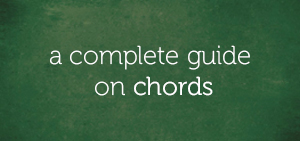In a previous post that received rave reviews, we studied the augmented triad.
I am dedicating this post to one of our blog readers who asked for the application of the augmented triad.
The augmented triad can be applied in so many ways, from being used in upper structures, to polychord voicings and passing chords, etc. (We’ll gradually cover these topics and more in future posts).
But in this post, we’ll be looking at the use of the augmented triad to form a matrix by building chord progressions around it.
The Augmented Triad
The augmented triad is formed by raising the fifth chord tone of a major triad by a semitone. If the fifth of C major:
…which is G:
…is raised by a half step to G#:
…this will produce C augmented triad:
Before we continue…
If you’re not familiar with augmented triads, or perhaps you want to know more about them, you’ll do well to read my post on them – a post in our free “16 Chords in 16 Weeks”, series where you’ll learn more and also get a chord cheat sheet from Jermaine Griggs – our president and founder.
*Going beyond this point shows you’re likely already familiar with augmented triads. However, for your reference, here are the augmented triads in all keys:
C augmented triad:
Db augmented triad:
D augmented triad:
Eb augmented triad:
E augmented triad:
F augmented triad:
Gb augmented triad:
G augmented triad:
Ab augmented triad:
A augmented triad:
Bb augmented triad:
B augmented triad
* The spelling of B augmented as B-D-G is because my virtual keyboard tool doesn’t spell accidentals like F## (pronounced F double sharp).
Ditone Progression
The ditone is a melodic progression in the same way the semitone (aka – “half step”) and whole tone (aka – “whole step”) are.
Division of the octave into a certain number of parts produces melodic progressions and the ditone is one of the common six melodic progressions we covered in the past.
The ditone divides an octave (12 notes or semitone progressions) into 3 equal parts.
If you do the math, 12 semitones / 3 parts = 4 semitones (aka – “half steps”).
This means that the distance of 4 semitones from any given note is a ditone.
If we move around the keyboard starting from C and using a ditone progression…
C to E is a ditone (the first ditone of the octave).
1st half step – C to C# (aka – “Db”):
2nd half step – C# to D:
3rd half step – D to D# (aka – “Eb”):
4th half step – D# to E:
…E to G# (aka – “Ab”) in turn is a ditone (the second ditone of the octave).
1st half step – E to F:
2nd half step – F to F# (aka – “Gb”):
3rd half step – F# to G:
4th half step – G to G# (aka – “Ab”):
…G# to C is a ditone (the third ditone of the octave).
1st half step – G# to A:
2nd half step – A to A# (aka – “Bb”):
3rd half step – A# to B:
4th half step – B to C:
Remember that the ditone is the division of the octave into three parts. Here are the three parts:
C to E – 1st ditone:
E to G# – 2nd ditone:
G# to C – 3rd ditone:
IMPORTANT
At this point, it is necessary for me to let you know that moving notes around in a ditone progression will outline an augmented triad.
This can represent a ditone in the key of C and a C augmented triad as well:
2-5-1 Progression in an Augmented Matrix
An augmented matrix simply means an augmented structure, outline or environment. So far, we’ve understood this structure and the relationship it has with the ditone progression.
In this segment, we’re taking our studies a step further by developing the 2-5-1 progression in an augmented matrix (or environment).
Before jumping to it, let’s review the 2-5-1 briefly.
2-5-1 Progression: Quick Review
The 2-5-1 is the movement of chords from the 2nd degree of the scale, to the 5th degree of the scale, before moving to the 1st degree of the scale.
Below are the seven degrees of the C major scale:
A 2-5-1 progression in this key will entail a movement from D (which is the 2nd degree):
…to G (which is the 5th degree):
…and finally to C (which is the 1st degree):
Click here to check out another comprehensive post exclusively on the 2-5-1 and how it can be played in all keys.
2-5-1 Progression: Augmented Matrix
In the key of C, we can create an augmented matrix by connecting the three notes in it, which are…
C:
E:
G#:
(To avoid the use of difficult spellings, I’ll use G# and Ab interchangeably henceforth.)
Now that the environment is set, the next thing is to connect 2-5-1 progressions in these keys – C, E and Ab.
This is where things get interesting…
Let’s learn the 2-5-1 progression in these three keys and move through the augmented matrix we just learned with them.
2-5-1 in C major

This 2-5-1 progression features three chords – Dmin9, G9 and Cmaj9.
2-5-1 in E major

The chords used in this 2-5-1 progression are – F#min9, B9 and Emaj9.
2-5-1 in Ab major

This 2-5-1 progression features three chords – Bbmin9, Eb9 and Abmaj9.
Final Words
The 2-5-1 progression we just learned in three keys can be connected like this:

This is one of those mind-blowing adventures in Jazz music.
Feel free to take it out of the regular Jazz context anytime and use it to spice up your playing by developing your 2-5-1 progressions in an augmented matrix.
Further study: The Coltrane Changes
Done for today, see you next time.
Chuku Onyemachi
Latest posts by Chuku Onyemachi (see all)
- The Formation Of Diminished Seventh Chords Used To Be Challenging Until I Did This
- How To Form Seventh Chords In Two Shakes Of A Dog’s Tail Using Third Intervals And The Circle Of Fifths Chart
- I Played The 13sus4 Chord And This Happened…
- How To Build Seventh Chords Like An Architect Using “Foundation And Structure” Concept
- This 4-Week Plan Will Help You Master All The Major Scales







Comments on this entry are closed.